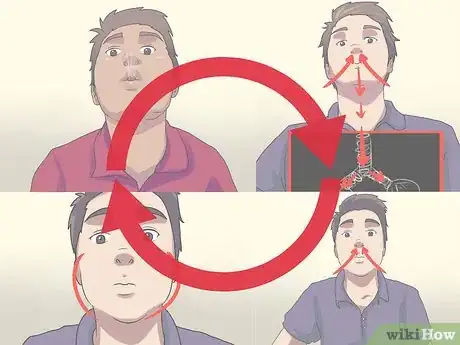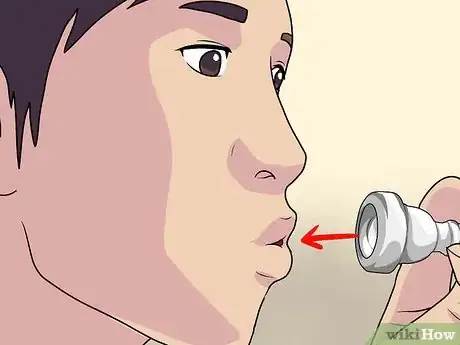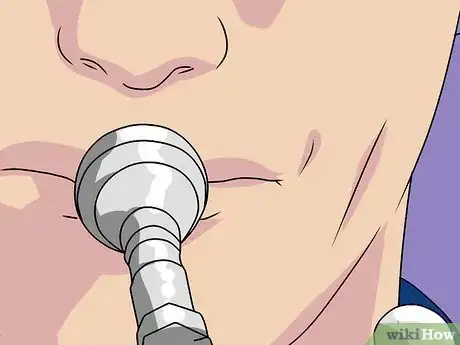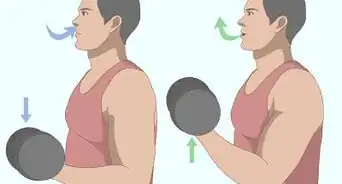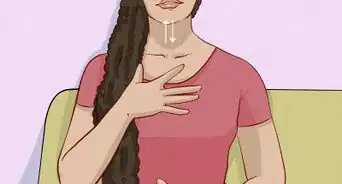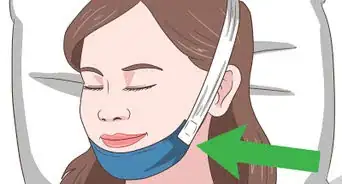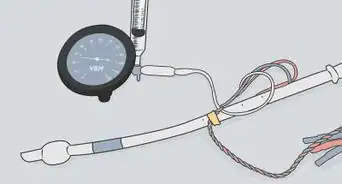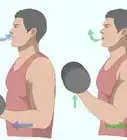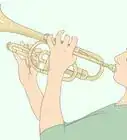wikiHow is a “wiki,” similar to Wikipedia, which means that many of our articles are co-written by multiple authors. To create this article, 33 people, some anonymous, worked to edit and improve it over time.
This article has been viewed 348,210 times.
Learn more...
In normal breathing, people usually inhale through the nose and exhale using just the lungs. For woodwind players, this process can be limiting. They can’t hold notes for as long as they may need to, and they can’t adapt some of the music written for other kinds of instruments. Circular breathing, a method that lets you exhale and inhale simultaneously, opens up more possibilities for these musicians. While relatively new to western music, circular breathing has been practiced in other cultures for centuries or longer, perhaps first developed by Aboriginal populations in Australia.[1]
Steps
Learning the Method
-
1Fill your cheeks with air, and breathe in and out through your nose. What you’re doing is establishing a second source of air that you can use when your lungs run out.[2]
- While this may make you look like a chipmunk, the more useful analogy is to think of yourself as a human bagpipe, and your cheeks as the bellows.[3]
-
2Blow out the air you have been holding in your mouth. Close your jaw, but make a tiny opening in your mouth, and use your cheek muscles to push the air out slowly.[4] Continue to breathe in deeply through your nose.[5] Control the motion so that it takes between three and five seconds to blow out the air in your mouth[6]
- Experts differ somewhat on this step. Some recommend keeping your cheeks puffed out the entire time, refilling them frequently with little bits of air from the lungs.[7] Others, however, suggest that it might be more natural to let your cheeks return to a normal breathing position as you let the air out of your mouth.[8]
- Experiment with both to determine which is more comfortable—and effective—for you and your instrument.
Advertisement -
3
-
4Fill your cheeks with air again. You should do this right before your lungs run out, so you have time to fill your lungs again while you are using the air stored in your mouth.[11]
-
5Repeat this sequence continuously. Once you are able to turn it into a seamless process, you will never have to pause to take a breath while playing your instrument again.[12]
Practicing
-
1Practice spitting. Spitting a thin stream of water can give you a good sense of the technique, in part because water is visible while air is not. Spitting while circular breathing will also more closely replicate the force you will need to produce sound on your instrument.[13]
- Fill your mouth with as much water as you can.
- Breathing in and out through your nose, spit the water into the sink in a thin, continuous stream.
-
2Use a straw. Pursing your lips around a straw will mimic the embouchure (mouth position) you use to play your instrument, so this is a good way to practice. Put a straw in a glass of water, and follow the steps for circular breathing while trying to blow in such a way that produces a constant stream of bubbles.[14]
-
3Vocalize. Circular breathing may have been first developed to play the didgeridoo, most often used to produce long, sustained notes. Teachers of this instrument suggest that vocalizing can lead to a smoother process.[15]
- Make a strong “HA” sound when switching from the air in your cheeks to the air in your lungs.
-
4Try your mouthpiece. Blowing through a straw can help with technique, but it won’t give you any sense of how it sounds. With just your mouthpiece, you’ll know if you’re producing sound without having to worry too much about its resonance or quality.[16]
- If you hear any noticeable break in the sound, you are probably waiting until one source of air is fully depleted before switching to the other one. Switch from your mouth to your lungs and vice versa the second before the one you are using runs out of air.
- This exercise is also helpful because it will give you a sense of how firmly you need to hold your lips for the technique to be successful.
Playing Your Instrument
-
1Try it as soon as possible. Don’t wait until you have mastered the technique in practice settings to apply it to your instrument. The only way to get better at it is to do it, so add the rest of your instrument as soon as you can make a sound using just your mouthpiece.[17]
-
2Work your way up. Do not start with complicated music, or with songs at all. Instead, start by holding single notes, then move on to easy, repetitive exercises. This will let you continue to perfect your technique.
- Some registers will make this easier than others. You may find it easier to start with exercises that hit the higher part of your instrument’s range.[18]
-
3Practice a little bit each day. Circular breathing can be mentally and physically tiring at first, so you might find it hard to keep it up for long. However, this doesn't mean that you should only practice once in a while. Instead, try three daily sessions of a few minutes each while you are learning the technique.[19]
References
- ↑ http://www.forthecontemporaryflutist.com/etude/etude-10.html#
- ↑ http://www.forthecontemporaryflutist.com/etude/etude-10.html#
- ↑ http://tamingthesaxophone.com/saxophone-circular-breathing
- ↑ http://www.didgeproject.com/index.php?option=com_content&view=article&id=139&Itemid=99
- ↑ http://www.forthecontemporaryflutist.com/etude/etude-10.html#
- ↑ http://www.woodwind.org/clarinet/Study/CircularBreathing.html
- ↑ http://tamingthesaxophone.com/saxophone-circular-breathing
- ↑ http://www.woodwind.org/clarinet/Study/CircularBreathing.html
- ↑ http://www.forthecontemporaryflutist.com/etude/etude-10.html#
- ↑ http://www.woodwind.org/clarinet/Study/CircularBreathing.html
- ↑ http://www.forthecontemporaryflutist.com/etude/etude-10.html#
- ↑ http://www.forthecontemporaryflutist.com/etude/etude-10.html#
- ↑ http://tamingthesaxophone.com/saxophone-circular-breathing
- ↑ http://www.woodwind.org/clarinet/Study/CircularBreathing.html
- ↑ http://www.didgeproject.com/index.php?option=com_content&view=article&id=139&Itemid=99
- ↑ http://www.woodwind.org/clarinet/Study/CircularBreathing.html
- ↑ http://www.woodwind.org/clarinet/Study/CircularBreathing.html
- ↑ http://tamingthesaxophone.com/saxophone-circular-breathing
- ↑ http://www.forthecontemporaryflutist.com/etude/etude-10.html#
- ↑ http://www.woodwind.org/clarinet/Study/CircularBreathing.html
- ↑ http://www.forthecontemporaryflutist.com/etude/etude-10.html#
- ↑ http://www.forthecontemporaryflutist.com/etude/etude-10.html#
About This Article
To circular breathe, start by filling your cheeks with air and breathing through your nose while you hold the air in your mouth. Next, use the muscles in your cheeks to slowly push out the air in your mouth for 5 seconds as you continue to breathe in through your nose. When the air in your mouth runs out, exhale air from your lungs. Then, right before the air in your lungs run out, fill your cheeks with air again by inhaling through your nose. Finally, practice repeating this cycle until it becomes a seamless process. For tips on how to practice circular breathing on your instrument, read on!




